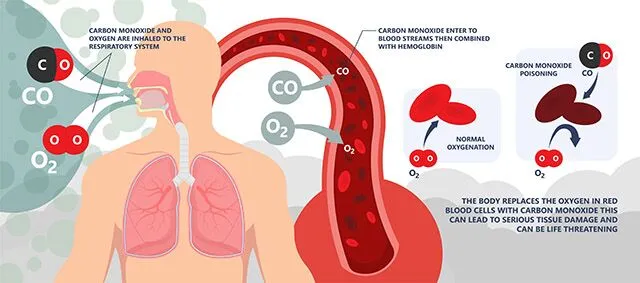
Receiving the maximum amount of compensation for Carbon Monoxide Poisoning that results in injuries, disabilities, or death, requires an experienced personal injury and wrongful death attorney advocate—someone with an established record of proving fault, damages, and a lawyer with a reputation for taking on big insurance.
As a rule, physical injuries caused by the concentration of carbon monoxide (CO), are unrepairable and may render the victim with a lifelong disability.
Allow me to explain how CO poisoning adversely alters the brain, heart, lungs, and other vital organs and tissues.
Toxic Carbon Monoxide and Oxygen Starvation
The intake of oxygen is necessary down to the cellular level. A single molecule of oxygen forms when two atoms of oxygen (O2) bond together and enter the bloodstream. How exactly does that happen?
When inhaling fresh air, oxygen molecules diffuse through the thin lining of the lung and disseminate into tiny capillaries, bringing oxygen rich blood to tissues and organs.
On the other hand, a carbon monoxide molecule (CO) is a compound consisting of two triple bonding elements: 1 carbon atom and 1 oxygen atom (C1+O1). These CO molecules enter the bloodstream in the same way as oxygen molecules, but instead of supplying oxygen, they starve tissues of life-sustaining oxygen. Any damage to cells is irreversible—however, immediate exposure to fresh air or oxygen is necessary to mitigate further damage to the body.
Incomplete Carbon Combustion Creates Carbon Monoxide
Carbon monoxide forms when there is a lack of oxygen. This absence of oxygen causes incomplete combustion of carbon-containing materials such as wood, oil, gasoline, natural gas, and more—to name a few.
For example, when a combustible engine fires up and is continuously running in a closed garage, the lack of fresh air creates a high concentration of CO. The inhalation of toxic CO fumes induces cellular damage to the brain, heart, lungs, and other tissues within the body—leading to injuries or death.

Carbon monoxide poisoning, the “Silent Killer”, is odorless, colorless, and undetectable until symptoms occur. By the time toxicosis symptoms develop, cellular damage is well underway. So the best way to prevent poisoning by CO fumes, is to install one or more CO detectors in homes and buildings.
US Statistics of Carbon Monoxide Poisoning
- Each year, more than 20,000 people are treated for carbon monoxide poisoning in U.S. emergency rooms. Approximately one-fifth, or 4,000 of those treated are admitted for advanced lifesaving treatment.
- Annually, more than 400 people needlessly die from unintentional carbon monoxide exposure.
Causes of Carbon Monoxide Poisoning
In the home, where most carbon monoxide incidents occur, CO poisoning may occur due to leaky appliances: ill-fitting parts, or the improper installation of fuel-burning appliances.
Accidental carbon monoxide poisonings can occur anywhere fuel is burned, and oxygen is limited. Furnaces, space heaters, water heaters, stoves, fireplaces, natural gas dryers, and ranges may all be suspects for potential CO poisoning. For this reason, it makes sense that fuel-burning appliances should be installed and annually maintained by licensed, professional technicians.
It is not uncommon for landlords to use a maintenance crew to address the daily problems of their tenants. However, most of these handy men and women, while talented at making general repairs, are not usually licensed in the trades and may not have the skills and experience that a certified and licensed technician possesses.
When the repair of a fuel-burning appliance involves improvising parts, or a faulty installation, the appliance leaking CO may become an undetectable life-threatening situation for minutes, hours or even days.
What Are the Symptoms of Carbon Monoxide Poisoning?
Symptoms of poisoning intensify with ongoing exposure. In the early stages of exposure, you may not experience any symptoms at all, but as carbon monoxide levels increase, you may become aware of a headache, or a slight loss of balance. Symptoms indicative of CO poisoning include light-headedness, confusion, dizziness, vomiting, vision impairment, shortness of breath, chest pain, and unconsciousness.
If you suspect exposure to CO, immediately remove yourself from the situation, seek as much fresh air as possible, and visit the emergency room for assessment and treatment if necessary.
Precautions For Reducing Risks of Accidental Death from CO Poisoning
I have put together a short list of items to consider if you have concerns about accidental CO poisoning. This list is by no means complete; I urge you to obtain additional information from the Center for Disease Control. In addition, there are many other websites available to learn more about protecting you and your family from CO poisoning. If you have concerns about CO in the workplace, OSHA has some comprehensive resources you can visit online.
Fireplaces, Wood-burning Stoves, and Chimneys
- Hire a professional chimney sweep annually to clear your chimney of carbon buildup and other obstructions. Your sweep should also inspect your fireplace box and flu.
- Professionally inspect and sweep a wood-burning stove annually. If your wood-burning stove has a catalytic converter, ask your sweep to inspect for operation and to clean the converter for the most efficient burn. Not all chimney sweeps are knowledgeable about catalytic converters, so you may want to ask your stove supplier/retailer for a referral.
- Seal a building too tightly, and this may increase your exposure to carbon monoxide. Before lighting your wood-burning fireplace or stove, open your chimney’s flue and create a draft by cracking a nearby window. Once you have determined the smoke is safely exiting the chimney, you may close the window.
- Engage a gas fireplace technician to clean and check your fittings annually.
Furnaces
- Ask a professional technician to service your furnace and flue annually.
- Change your furnace filter according to manufacturer instructions.
Ranges and Cooktops
- If you have a gas range/stove, solicit a licensed technician once a year to inspect all fittings on your range or cooktop.
- Space Heaters
- Space heaters in enclosed areas can pose a risk, particularly when fueled by propane, natural gas, or kerosene fuels. Educate yourself about the safe operation of your space heater before you use it. Never fall asleep or leave the room while in use. When purchasing a space heater, look for the stamp of approval by Underwriting Laboratories (UL).
Combustible Engines
- Running your combustible engine vehicle in a garage, creates a toxic build-up of exhaust fumes. Always open the garage door before starting your vehicle. This can be especially worrisome if you use a remote starter and forget to open the garage door. Warn all family members about the dangers of running a car in an enclosed garage.
- When idling, or driving your vehicle in deep snow, check that the tail pipe is not resting or suffocated in a snow drift. Exhaust fumes can back-up inside your vehicle creating a potentially deadly situation for you and your passengers.
Carbon Monoxide Alarm
- Change the batteries on your CO detector once a year; pick a date and stick with it. It may save your life!
Insurance Coverage for Carbon Monoxide Poisoning and Pollution Exclusions
Many Homeowners and Commercial General Liability (CGL) insurance policies have language built into their policies known generally as the pollution exclusion. Throughout the country, state courts have had varying opinions about allowing insurance companies to apply the pollution exclusion in cases involving carbon monoxide poisoning. For this reason, I strongly recommend consulting with an experienced attorney before bringing a claim for faulty installation or repairs of the fuel-burning appliance.

Indianapolis Carbon Monoxide Poisoning FAQs
Our Indianapolis, IN carbon monoxide poisoning lawyer can help victims and their families pursue compensation by proving negligence and building strong cases. Carbon monoxide poisoning can lead to serious injuries or even death, making it essential to determine who is responsible. Holding the right party accountable requires strong evidence, a clear understanding of safety regulations, and knowledge of legal responsibilities. Below, we address common questions about establishing liability in carbon monoxide poisoning lawsuits.
How Do We Prove Who Is Responsible For Carbon Monoxide Poisoning?
Proving responsibility in a carbon monoxide poisoning case requires showing that someone’s negligence directly caused the exposure. Liability may fall on a landlord, property owner, manufacturer, maintenance company, or employer. Property owners can be held accountable if they fail to install or maintain carbon monoxide detectors, neglect proper ventilation, or ignore necessary appliance upkeep. Manufacturers may be liable if a defective furnace, water heater, or other fuel-burning appliance releases unsafe levels of carbon monoxide. Maintenance companies and service providers can also bear responsibility if they improperly install or repair equipment, leading to exposure. Employers who fail to provide proper safety measures in workplaces where carbon monoxide is a risk can also be held accountable. To support a claim, our award-winning Indianapolis carbon monoxide poisoning lawyer works with investigators to examine maintenance records, review building safety compliance, and identify any ignored warnings or safety violations.
What Evidence Is Needed To Support A Claim?
A strong claim depends on solid evidence proving exposure, negligence, and harm. Essential documentation includes medical records that show carbon monoxide poisoning, toxicology reports, and incident reports from emergency responders or safety inspectors. Air quality tests, carbon monoxide detector logs, and reports detailing previous safety violations can provide further proof of unsafe conditions. Witness statements from tenants, coworkers, or family members can also support a case, especially if they describe previous complaints about faulty appliances or ventilation problems. Photographic and video evidence of malfunctioning equipment, blocked vents, or missing carbon monoxide detectors can strengthen the argument that negligence played a role. Maintenance logs revealing overdue inspections or ignored repairs also serve as critical evidence when demonstrating liability.
Can Landlords Or Property Owners Be Held Responsible?
Landlords and property owners have a legal duty to provide a safe living environment, and failing to protect tenants from carbon monoxide exposure can make them liable for damages. Common violations that lead to lawsuits include failing to install or maintain carbon monoxide detectors, ignoring complaints about malfunctioning heating systems, renting out properties with outdated or hazardous appliances, or allowing ventilation systems to become blocked or improperly sealed. State and local building codes require landlords to meet specific safety standards, including installing carbon monoxide detectors in rental units. If a property owner violates these regulations and their negligence results in poisoning, they can be held accountable in court.
If you or a loved one have suffered from carbon monoxide poisoning, we are here to help. At Ward & Ward Personal Injury Lawyers, we focus on holding negligent parties accountable so that victims receive fair compensation. Contact our Indianapolis carbon monoxide poisoning lawyer today for a free consultation to discuss your case and explore your legal options.
Seek A Free Consultation With An Experienced Attorney Advocate
If you or someone you love has exposure to a carbon monoxide event resulting in death or serious injuries, please call Ward & Ward Personal Injury Lawyers for a free consultation. Why wait? Call (317) 639-9501 and ask for attorney Charlie Ward today.
Learn more about our personal injury attorneys in Indianapolis, Indiana.


